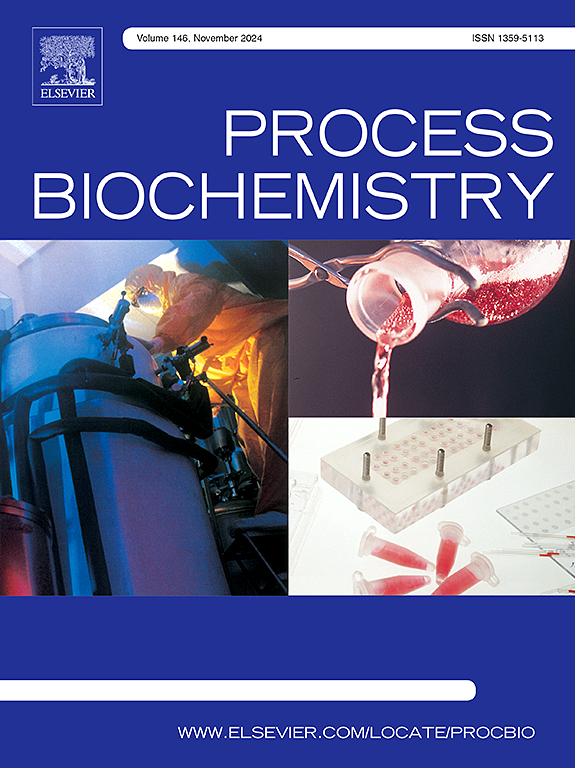生物电fenton系统去除合成废水中偶氮染料的性能评价
IF 3.7
3区 生物学
Q2 BIOCHEMISTRY & MOLECULAR BIOLOGY
引用次数: 0
摘要
本研究旨在评价生物电fenton (BEF)体系对雷马唑艳紫-5R (RBV-5R)的去除效果。在不同条件下进行了三次实验,RBV-5R浓度为5、10和20 mg L−1,外部阻力(ext)为1000、100和10 Ω,水力滞留时间(HRT)为12 h。在20毫克L−1 RBV-5R和10Ω,去除效率的颜色、芳香组,和化学需氧量(COD)达到95.5 ±0.25 %, 73.6±0.4 %,和82.4 ±0.3 %,分别。在最大功率密度为69.4 mW m−2时,测得残余过氧化氢(H2O2)浓度为12.25 ± 0.17 mg L−1,库仑效率和法拉第效率分别为7.2 ± 0.4 %和5.81 ± 0.1 %。植物毒性试验表明,经12 h处理后,油菜和红花的萌发指数(GI)从6 ~ 39%提高到 %。残余H2O2与微生物群落呈强正相关(r = 0.926,p <; 0.01),说明阳极生物膜可以促进Fenton反应阴极H2O2的生成。这些结果支持BEF系统作为一种有前途的偶氮染料去除技术,无需外部能量或H2O2添加。本文章由计算机程序翻译,如有差异,请以英文原文为准。
Performance assessment of a bio-electro-Fenton system for azo-dye removal from synthetic wastewater
This investigation aimed to evaluate the application of a bio-electro-Fenton (BEF) system for Remazol brilliant violet – 5R (RBV-5R) removal. Three experimental runs were conducted under varied conditions using RBV-5R concentrations of 5, 10, and 20 mg L−1, external resistances (Rext) of 1000, 100, and 10 Ω, and a hydraulic retention time (HRT) of 12 h. At 20 mg L−1 RBV-5R and 10 Ω, removal efficiencies for color, aromatic groups, and chemical oxygen demand (COD) reached 95.5 ± 0.25 %, 73.6 ± 0.4 %, and 82.4 ± 0.3 %, respectively. A residual hydrogen peroxide (H2O2) concentration of 12.25 ± 0.17 mg L−1 was measured at a maximum power density of 69.4 mW m−2, with Coulomb and Faraday efficiencies of 7.2 ± 0.4 % and 5.81 ± 0.1 %. Phytotoxicity assays showed that the germination index (GI) for L. sativa and R. sativus increased from approximately 6 – 39 % after 12 h. A strong positive correlation (r = 0.926, p < 0.01) between residual H2O2 and the microbial community suggests that the anodic biofilm may enhance H2O2 generation at the cathode for the Fenton reaction. These results support BEF systems as a promising technology for azo dye removal without external energy or H2O2 addition.
求助全文
通过发布文献求助,成功后即可免费获取论文全文。
去求助
来源期刊

Process Biochemistry
生物-工程:化工
CiteScore
8.30
自引率
4.50%
发文量
374
审稿时长
53 days
期刊介绍:
Process Biochemistry is an application-orientated research journal devoted to reporting advances with originality and novelty, in the science and technology of the processes involving bioactive molecules and living organisms. These processes concern the production of useful metabolites or materials, or the removal of toxic compounds using tools and methods of current biology and engineering. Its main areas of interest include novel bioprocesses and enabling technologies (such as nanobiotechnology, tissue engineering, directed evolution, metabolic engineering, systems biology, and synthetic biology) applicable in food (nutraceutical), healthcare (medical, pharmaceutical, cosmetic), energy (biofuels), environmental, and biorefinery industries and their underlying biological and engineering principles.
 求助内容:
求助内容: 应助结果提醒方式:
应助结果提醒方式:


